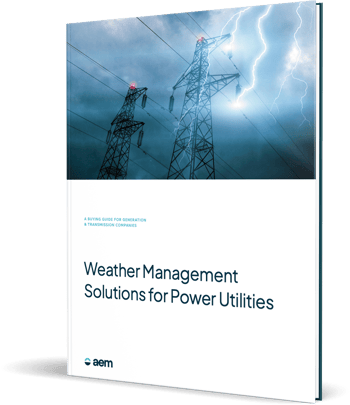A BUYING GUIDE FOR GENERATION & TRANSMISSION COMPANIES:
Weather Management Solutions for Power Utilities

Power and energy utilities have the responsibility of providing electricity to keep people safe, warm, fed, and alive. Whether you’re an Investor-Owned Utility (IOU), a municipal provider, or part of a rural co-op, you need to protect your infrastructure, communicate with your customers, and provide services in a consistent way that people can believe in.
In this buying guide we will cover the following topics:
- Three stages of developing an effective weather policy
- Key features of a weather monitoring and management system for power utilities
- Selecting the right weather services vendor
Three stages of developing an effective weather policy
Building the ideal weather monitoring and alerting solution for your utility requires a deep understanding of your specific needs, service area, and existing operating procedures. Over the last 25 years, we've found that an effective approach to mitigating weather risks includes three easy-to-remember stages: Analyze, Plan, and Implement.
Analyze
The first step toward total weather preparedness is understanding exactly where the risks, exposures, and potential losses exist in your current approach. Key points to analyze include:
- Assets or exposures
- Activities and events
- Threats posed by weather variables
- Legal and regulatory guidelines
- Emergency response
Plan
The second step is drafting a practical, actionable plan for weather monitoring, threat detection, and response planning based on the analysis you’ve carried out. This stage includes:
- Tracking Your Requirements
- Developing a Plan of Action
- Detailing an Effective Communication Strategy
Implement
Once you’ve built a clear plan for tracking, responding to, and communicating about weather emergencies, it’s time to put that plan into action. Below are just a few items to consider adding to your implementation checklist:- Identify and install technology or technologies to support your policies (part of your weather solution)
- Activate alerts for your established protocols (part of your weather solution)
- Disseminate policies and procedures internally
- Share and validate policies and procedures with collaborating response agencies
Key features of a weather monitoring and management system for power utilities
A weather-ready utility relies heavily on thorough safety protocols, advanced monitoring and alerting technologies, and the established expertise of professional meteorologists. Meeting utility providers’ increasingly complex monitoring and response needs requires a complete weather management toolkit made up of the following components.
Real-Time Weather Map and Mobile App
A real-time weather map and mobile app combination enable you to plan for incoming weather events and keep at-risk stakeholders safe. Interactive weather maps visualize data in real-time with animated layers and storm “time of arrival” estimates to help you prepare for anything that comes near your service area. Read more...
Custom, On-Demand Forecast Support
With on-demand meteorological services, you gain access to a team of meteorologists who can help you understand current conditions better, prepare for incoming weather, or plan your response. This can be the difference between total operational continuity and a potentially damaging, costly service interruption. Read more...
Lightning Detection and Alerts
Lightning is one of the biggest threats to power utilities. That’s why understanding where and when lightning is striking or approaching your service area is crucial. With a lightning alert system, you can gain insights into dangerous electrical storms that will help you and your colleagues at local emergency response agencies minimize the impact of lightning in your area. Read more...
Live High-Definition Cameras
Strategically placed high-definition cameras allow your team to scan your service area for smoke, heat, or visible fire from a central command center or any network-enabled device. That live look into the field maximizes threat visibility and accelerates your response to save lives, protect infrastructure, and ensure continuity of service. Read more...
Flood Monitoring and High-Water Alerts
Like wildfires, floods are becoming more frequent and more damaging in many parts of the country. To maximize safety in your community and protect infrastructure, you need to know when and where floods are beginning to develop and when water levels reach limits that could threaten your customers, workers, or generation equipment.
- Check with industry resource groups and member organizations
- Check customer reviews
- Make sure they support your A-P-I
- Do research and request proposals
- Evaluate top contenders